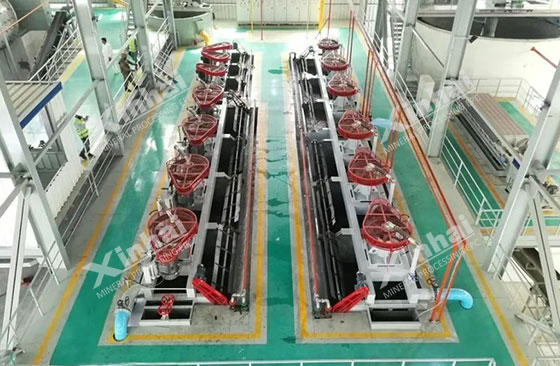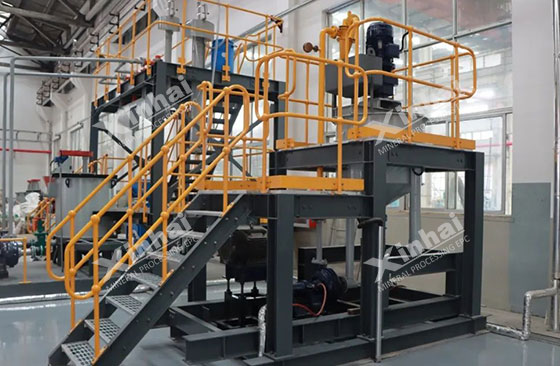Lithium is a relatively light metal element in nature with extremely strong electrochemical activity. It is widely used in high-energy batteries, aerospace, nuclear fusion power generation and other fields. Lithium resources are mainly found in granite pegmatite deposits and salt lake brine deposits. Among them, spodumene is one of the main sources of lithium, usually produced in muscovite and lepidolite granite pegmatites. For the beneficiation of lithium spodumene, multiple methods are used in parallel, including lithium spodumene pre-de-sludging, flotation, heavy medium, magnetic separation and combined beneficiation, aiming to improve beneficiation efficiency and concentrate quality.
Use the table of contents below to navigate through the guide:
01Preliminary desliming of lithium spodumene
Preliminary desliming is suitable for lithium spodumene pretreatment before flotation and heavy media separation. In the flotation system, the presence of a large amount of slime will reduce the dispersion of minerals, waste chemicals, and even enhance the activation of gangue minerals, affecting the flotation effect of spodumene. Therefore, the desliming operation before sorting is very important. If the lithium spodumene ore contains a large amount of mica-like gangue minerals, the grinding fineness can be adjusted to -0.074 mm accounting for 75%, and dodecamine or cocoamine can be used as the collector of gangue minerals, and sulfuric acid can be used at the same time. Adjust slurry pH to 3. This treatment can effectively improve the flotation slurry environment and significantly improve the grade of spodumene concentrate.

02Lithium spodumene flotation method
Flotation is a commonly used method in lithium spodumene beneficiation. It uses the difference in physical and chemical properties of the mineral surface to separate spodumene from gangue minerals through flotation agents. Flotation can be divided into two methods: positive flotation and reverse flotation.
1. Lithium spodumene positive flotation method
The positive flotation method of spodumene is carried out in an alkaline medium. Usually, after the spodumene is ground, a strong alkali is added for flotation. In the process of high concentration, strong stirring and multiple scrubbing and desludging, oleic acid and its soap salts are added as collectors to directly float out spodumene, while leaving the gangue minerals in the tank. This process does not require the addition of inhibitors. Sodium hydroxide reacts with silicate minerals in the slurry to form sodium silicate (water glass), which plays an inhibitory role and effectively inhibits the flotation of gangue minerals, allowing spodumene to float out. Through this method, lithium spodumene is preferentially floated in an alkaline environment, and gangue minerals are inhibited by generating insoluble compounds due to surface activated cations (such as iron, calcium, copper, etc.), thereby achieving the purpose of separation.

2. Lithium spodumene reverse flotation method
The reverse flotation method of spodumene uses lime to create an alkaline environment (pH 10.5~11.0), adds inhibitors such as starch and dextrin to inhibit the floating of spodumene, and uses cationic collectors to float silicate gangue minerals such as quartz, feldspar and mica. If spodumene contains iron minerals, a frother (such as HF resinate) can be added to further remove impurities such as iron minerals. The reverse flotation method is mainly carried out in an alkaline medium, and lithium spodumene and gangue minerals are successfully separated through inhibition and selective flotation.

03Lithium spodumene heavy medium separation method
The heavy medium separation method of lithium spodumene is suitable for ores with coarse crystal size. Its basic principle is to use the difference in specific gravity between spodumene and gangue minerals to separate them through a heavy medium cyclone. The desludging spodumene is mixed with heavy medium (mainly heavy suspension) and enters a heavy medium cyclone for separation at a pressure of 0.05-0.20MPa. Heavy products and light products are obtained. The heavy product becomes spodumene concentrate after being processed by the desludging screen, and the light product becomes tailings. This method can effectively separate spodumene from gangue minerals.

04Lithium spodumene magnetic separation method
Spodumene is a weakly magnetic mineral, so magnetic separation can be used as an auxiliary measure to improve the quality of lithium concentrate. Magnetic separation is mainly used to remove iron impurities in spodumene concentrate. High-gradient magnetic separators and other strong magnetic separation equipment are usually used to remove weakly magnetic minerals in the ore to obtain low-iron spodumene concentrate. This method is simple to operate, easy to control and highly adaptable. When single magnetic separation cannot effectively remove iron, the iron removal operation can be further completed through a combined process, thereby effectively improving the quality of lithium spodumene.

05Lithium spodumene combined beneficiation method
The combined beneficiation method is mainly used for lithium spodumene ores with complex associated components. It is difficult for a single beneficiation method to effectively recover lithium concentrate minerals. By combining multiple beneficiation processes, the combined beneficiation method can be more effectively selected. Common combined beneficiation methods include flotation-magnetic separation process and flotation-gravity separation-magnetic separation process.
The flotation-magnetic separation process first performs flotation. After obtaining the spodumene concentrate, strong magnetic separation is used to remove iron impurities, thereby obtaining a high-purity spodumene concentrate. The flotation-gravity separation-magnetic separation process first grinds the ore for slurry adjustment, and then performs gravity separation to remove impurities such as tantalum and niobium. The gravity separation tailings enter the flotation stage after concentration and desludging, and then the spodumene is further purified by magnetic separation. These combined beneficiation methods can effectively deal with the problem of complex associated components of lithium ores and improve the quality of spodumene concentrate.

Before the selection and production, it is recommended to conduct lithium spodumene beneficiation tests and customize scientific beneficiation plans based on comprehensive indicators such as ore properties and investment budget to avoid waste of resources caused by inappropriate selection processes. Through the comprehensive application of these methods, the beneficiation efficiency and concentrate quality of spodumene can be effectively improved.


 marketing@ytxinhai.com
marketing@ytxinhai.com  0086 13810327080
0086 13810327080 






































































































 CHAT
CHAT MESSAGE
MESSAGE








